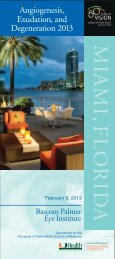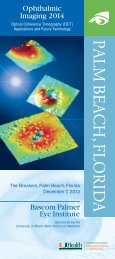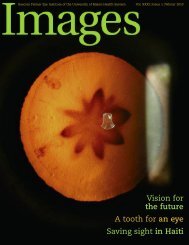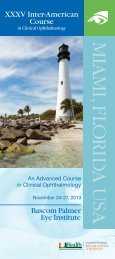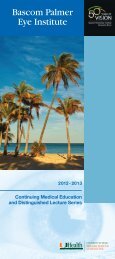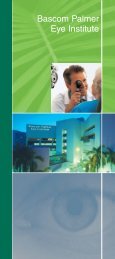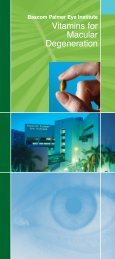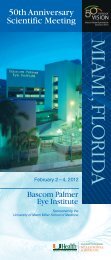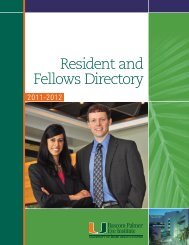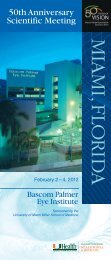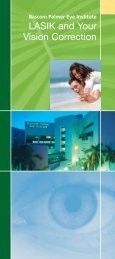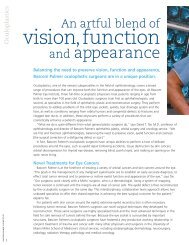Images Magazine Spring 2013 - Bascom Palmer Eye Institute
Images Magazine Spring 2013 - Bascom Palmer Eye Institute
Images Magazine Spring 2013 - Bascom Palmer Eye Institute
- No tags were found...
You also want an ePaper? Increase the reach of your titles
YUMPU automatically turns print PDFs into web optimized ePapers that Google loves.
U.S. retina specialists now collectively perform an estimated 170,000 vitrectomies each year, withperhaps three times as many being done in the rest of the world – all thanks to this <strong>Bascom</strong> <strong>Palmer</strong>innovation.Through the decades, Parel and his team have invented or improved more than 350 devices,including the world’s smallest motorized scissors, which were used to cut retinal membranes thatobscure vision. At one point, Parel alone had more patents than the entire medical school facultycombined. “Dr. Norton had a view of the future so far reaching it was unbelievable,” said Parel.“He recognized how biophysical engineering could make a huge difference in ophthalmology.”Meanwhile, clinicians and scientists in <strong>Bascom</strong> <strong>Palmer</strong>’s research laboratories were studyingglaucoma and a wide range of othervision-impairing conditions.In the 1970s, Douglas R. Anderson,M.D., was the first to demonstrate anabnormal physiologic process in the opticnerve of glaucoma patients. “We hadknown that pressure damaged the nerve,-Harry W. Flynn, Jr., M.D. but were not sure if it was due to theblood flow or something else,” he said.“We demonstrated a blockage of fastaxonal transport – a vital process to the neurons. We found that elevation of pressure affected thatnerve, and demonstrated that this was secondary, at least in part, to a deficiency in the blood flow.”In 1973, Robert W. Knighton, Ph.D., joined the research faculty, and began studying howto improve clinical imaging of the tissues of the eye. Knighton was in charge of the clinicalelectrophysiology research program, exploring a technology then in its infancy. He looked for new waysto improve electroretinograms that provided clearer diagnostic images to ophthalmic surgeons.“The driving force behind the <strong>Bascom</strong><strong>Palmer</strong> <strong>Eye</strong> <strong>Institute</strong> is the high quality ofthe residents and fellows.”Laser Research BeginsOphthalmologists began experimenting with lasers in the late 1960s and early 1970s forphotocoagulation treatments, using first ruby-red light and later argon blue-green lasers to heattiny spots on the retina. In 1978, <strong>Bascom</strong> <strong>Palmer</strong>’s ophthalmic biophysics center added a laser101978Service to veteransGuy O’Grady, M.D., ran theophthalmology programat the Miami Veteran’sAdministration Hospital formore than 30 years. <strong>Bascom</strong><strong>Palmer</strong> continues to serveAmerica’s veterans.1981 FactsNumber of patients56,000Surgical procedures5,1001979Curso launchedEnglish-Spanish translation is provided at<strong>Bascom</strong> <strong>Palmer</strong>’s popular Inter-AmericanCourse in Clinical Ophthalmology, “CursoInteramericano,” attended each year byhundreds of ophthalmologists from LatinAmerica and the Caribbean.



